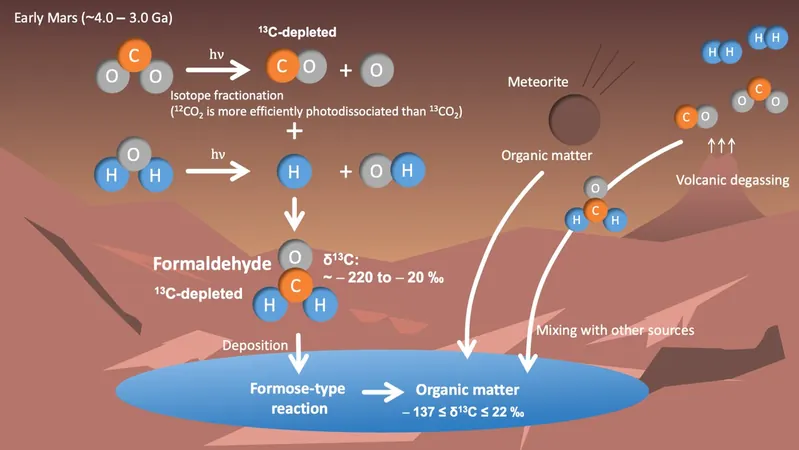
Groundbreaking Research Unveils Mars' Mysterious Organic Matter Origins Linked to Formaldehyde
2024-09-19
In a monumental discovery that deepens our understanding of the Red Planet's past, researchers from Tohoku University have unveiled a detailed model suggesting that the organic matter found on Mars may have originated from atmospheric formaldehyde. This new insight ties back to the time when liquid water was prevalent on Mars, approximately 3 to 4 billion years ago, a period that raises tantalizing questions about the potential for life.
Mars, known for its cold and arid environment today, once harbored rivers and possibly oceans. The existence of water is closely associated with life as we know it, prompting scientists to investigate Martian geology for signs of past biological activity. The stable carbon isotope ratio, specifically the difference between carbon-12 and carbon-13 (13C/12C), found in organic materials on Mars serves as a crucial indicator of how this organic matter was formed, guiding researchers on a path to ancient life forms.
Among the key players in this pioneering research is the NASA-operated Curiosity rover, which has been instrumental in revealing organic particles in Martian sediments. Findings included an intriguing depletion of 13C in these samples, coupled with significant variability in carbon isotope ratios across different locations. This perplexity posed a challenge that urged scientists to seek deeper explanations.
Led by Shungo Koyama, Tatsuya Yoshida, and Naoki Terada, the team tackled this mystery by developing a comprehensive Martian atmospheric evolution model, recently published in the journal *Scientific Reports*. Their investigation zeroed in on formaldehyde (H2CO), a compound they hypothesized could have been synthesized in Mars' early atmosphere.
The rationale for focusing on formaldehyde is compelling: this simple molecule can undergo reactions to form complex organic compounds, such as sugars, which are foundational for life. The researchers propose that formaldehyde might bridge the gap in understanding the unusual carbon isotope values observed by Curiosity, signaling a possible connection to ancient biological processes.
Utilizing a sophisticated combination of photochemical and climate models, the researchers traced changes in the carbon isotope ratios of formaldehyde over 3 to 4 billion years. They discovered that the depletion of 13C can be attributed to the photodissociation of CO2 under solar ultraviolet radiation, leading to a preferential formation of one stable isotope over another.
Moreover, the study highlighted how variations in carbon isotope ratios could arise from several factors, including historical atmospheric pressure, the reflectivity of Mars' surface, ratios of carbon monoxide to carbon dioxide, and volcanic hydrogen emissions—all of which create a complex interplay that might have shaped the planetary atmosphere.
"This model offers a compelling explanation for the previously puzzling findings of depleted 13C levels observed on Mars," states Koyama, a graduate student involved in the study. As scientists continue to unravel the enigmatic history of Mars, this research not only deepens our understanding of the planet's geological past but also fuels the curiosity about the possibilities of ancient life forms that may have once thrived in its once-watery environment.
With future missions planned to explore Mars further, including sample return efforts, researchers remain hopeful that more discoveries will illuminate whether life ever existed on the Red Planet. Stay tuned as we continue to journey through the mysteries of our solar system!

 Brasil (PT)
Brasil (PT)
 Canada (EN)
Canada (EN)
 Chile (ES)
Chile (ES)
 España (ES)
España (ES)
 France (FR)
France (FR)
 Hong Kong (EN)
Hong Kong (EN)
 Italia (IT)
Italia (IT)
 日本 (JA)
日本 (JA)
 Magyarország (HU)
Magyarország (HU)
 Norge (NO)
Norge (NO)
 Polska (PL)
Polska (PL)
 Schweiz (DE)
Schweiz (DE)
 Singapore (EN)
Singapore (EN)
 Sverige (SV)
Sverige (SV)
 Suomi (FI)
Suomi (FI)
 Türkiye (TR)
Türkiye (TR)